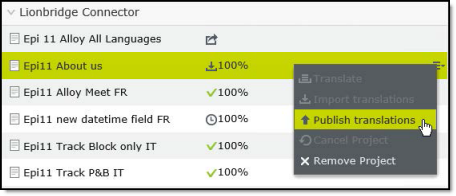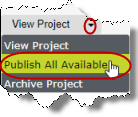Publishing Translated Assets
After you import translated content, you can publish the corresponding assets from the Connector. Alternatively, you can publish assets individually from the regular Episerver publishing method, as described in the last step of Reviewing Translated Assets.
Publishing translated assets from the Connector is available only when the project is in Imported status, or if it is displayed, in italics, in either In Translation or Ready for Import status, which indicates that some of the project content may already be imported into Episerver. For more information, see the note about status displayed in italics in Monitoring Translation Projects.
To import and publish a page, all its dependent blocks must be translated.
The Connector automatically updates translation projects with redelivered assets. If a published project has redelivered assets, its status is 100%.
For instructions on importing and reviewing content before publishing it, see Importing Translated Content.
There are three ways to publish translated assets:
1 - Publishing All Available Translated Assets from the Gadget
After you import translated content, you can publish the corresponding translated assets.
This feature is available only when the project is in Imported status, or if it is displayed, in italics, in either In Translation or Ready for Import status, which indicates that some of the project content may already be imported into Episerver. For more information, see the note about status displayed in italics in Monitoring Translation Projects.
For more information about publishing translated assets, see Publishing Translated Assets.
To publish translated assets from the Lionbridge Connector gadget:
- In Episerver CMS, click Edit.

- Click the Toggle assets pane icon.

The Assets pane is displayed on the right. The Lionbridge Connector gadget is displayed at the bottom of the pane, displaying all the translation projects.
-
Click a project in the list to select it.
-
Mouseover the right end of the project in the Lionbridge Connector gadget, click the Options icon  and then select Publish translations in the project’s context menu. This menu item is available only when the project is in Imported status.
and then select Publish translations in the project’s context menu. This menu item is available only when the project is in Imported status.

A message box opens, confirming that the pages are being published.
- Click OK to close the message box.
2 - Publishing All Available Translated Assets from the Dashboard
After you import translated content, you can publish the corresponding translated assets.
This feature is available only when the project is in Imported status, or if it is displayed, in italics, in either In Translation or Ready for Import status, which indicates that some of the project content may already be imported into Episerver. For more information, see the note about status displayed in italics in Monitoring Translation Projects.
For more information about publishing translated assets, see Publishing Translated Assets.
To publish all available translated assets from the Dashboard:
-
In the Dashboard, locate a translation project with Imported status. This is displayed in the Status column. For information on opening the Dashboard, see Getting Started with the Connector for Episerver.
-
In the Actions column, click the arrow and select Publish All Available from the context menu.

A message box opens, confirming that you want to publish all available assets in the project.
- Click Yes to proceed.
Another message box opens, stating that the project was published.
- Click OK to close the message box.
3 - Publishing Translated Assets in One Target Language from the Dashboard
Publishing Translated Assets in One Target Language from the Dashboard
After you import translated content, you can publish the corresponding translated assets.
In the Lionbridge Connector Dashboard, either:
- The displayed project status is Imported.
- The project status is displayed, in italics, in either In Translation or Ready for Import status, which indicates that some of the project content may already imported into Episerver. For more information, see the note about status displayed in italics in Monitoring Translation Projects.
For more information about publishing translated assets, see Publishing Translated Assets.
To publish translated assets from the Dashboard:
-
In the Dashboard, locate the translation project whose translated assets you want to publish. For information on opening the Dashboard, see Getting Started with the Connector for Episerver.
-
Click the Expand icon  on the left side of the translation project whose assets you want to publish.
on the left side of the translation project whose assets you want to publish.
The translation-project row expands, displaying the status of the translation of each target language in the project and any relevant actions. For a detailed description of this section, see Monitoring Translation Assets.

- Click Publish for target-language assets to publish.
A message box opens, confirming that you want to publish the assets in this target language.
- Click Yes to proceed.
Another message box opens, stating that the assets were published.
- Click OK to close the message box.



